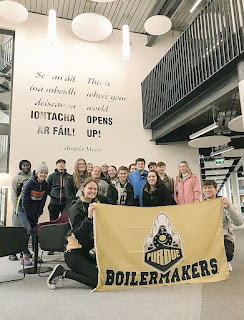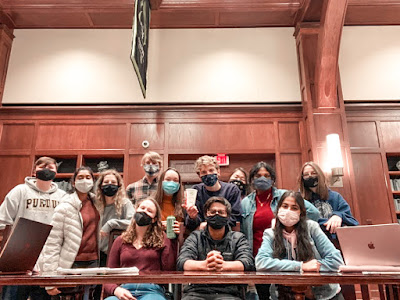Spring Break Study Abroad: Ireland Edition!
Of course, travel requires a good deal of preparation in advance! For me, this was my first experience leaving the U.S. and so one of my very first steps was acquiring my passport. However, your program may require pre-departure presentations or assignments in addition to expected travel paperwork- mine only required one pre-departure meeting, but longer programs may require more. One assignment we were required to complete was the Intercultural Development Inventory (IDI) assessment, to provide a measure before and after the trip on our measures of cultural acceptance and understanding. Our post-arrival assignments are daily paragraph summaries, and a two-minute video on an assigned topic - mine is Trinity College Dublin. These assignments are a way to recap the travel experience, as well as put in the work required for the 1-week, 1-credit course.
The first aspect of our study abroad experience was learning more about the culture of Dublin and Ireland as a whole. Our first cultural visit was to Kilmainham Gaol, a prison in Dublin that is central to the independence of Ireland from the U.K. and its development into a republic. This was a way for students to understand the history of injustice and political unrest in Ireland, and that some of those divides still linger somewhat in modern culture 100 years after the Civil War. Our next cultural visit was EPIC The Irish Emigration Museum, which explained some of the significant contributions and innovations that Ireland has made to the rest of the world, as well as more of Ireland’s culture such as historical details and their national sports. The museum was established to explore more about why traces of Ireland can be found globally, not just in objects but also in people. Many people emigrated from Ireland during the Great Famine, though approximately one million deaths are attributed to starvation as well. While the diaspora has helped to share Irish culture elsewhere in the word and many people can trace their lineage to Irish descent, Ireland has never recovered their pre-famine population and it remains a painful topic for the country. Our next experiential opportunity to be exposed to Irish culture was watching traditional Irish dance and music at Taylors Three Rock, which was a blast as we were surrounded by lively music and some of Purdue’s students were invited to dance. After a couple days of company visits and site tours, our look into Ireland’s history continued with a tour of the Book of Kells, an illustrated and illuminated version of the Gospels written in Latin. The Book of Kells is housed in the library of Trinity College Dublin, famous for its “Long Room” which inspired some of the architecture found in the Harry Potter series. Our last day in Dublin was spent enjoying what most people likely know Ireland for: St. Patrick’s Day! The special part about spending St. Patrick’s Day in Dublin is that we were able to watch our own All-American Marching Band in the parade. Our next day was spent in Limerick and on a journey to the Cliffs of Moher. We began the day by walking to Limerick’s Milk Market, and on the way to the Cliffs we were fortunate to taste milk…from a vending machine! Moo’ghna Milk delivers fresh, creamy milk to its stand each day, where customers can choose to fill their glass bottles with plain or flavored non-homogenized milk to create a fresh milkshake. We were lucky to be guests on the dairy farm of Moo’ghna Milk where we learned more about the processes of pasteurization and homogenization, and met some of the dairy cows and their adorable little calves. The Cliffs of Moher were a beautiful sightseeing experience on the west coast, and despite the windy conditions we had clear enough weather to see all of the Aran islands from the Cliffs.
For the academic portion of our study abroad, our first site visit and training was at NIBRT: The National Institute for Bioprocessing Research and Training. Purdue is hoping to model a program similar to NIBRT, that would allow industry partners to train their employees on the practices of bioprocessing through simulations and hands-on practice. As part of our experience, we were given lectures and practicals in the training labs on the basis of biopharmaceutical manufacturing and disposable technologies. This background knowledge was helpful for our next day, which was spent with Amgen and APC/VLE. At Amgen, we received a lecture and “virtual tour” of the facility, with an emphasis on the specific products that the site manufactures in Dublin and their fill/finish processes. APC/VLE, or “The Medicine Accelerator”, is a start-up company that focuses on generating advanced cell and gene therapies, as well as vaccines. APC works with pharmaceutical and biotech companies for the accelerated development of large molecule drugs, while VLE develops and improves the manufacturing processes for these medicines. Everyone loved the brand-new facility of The Medicine Accelerator, which allowed us to see inside the labs where research is being done as well as outside the facility where both the mountains and ocean outside of Dublin were visible. Our APC/VLE visit was followed up with a masterclass and tour at the University College Dublin, which offers a master's program similar to Purdue’s 4+1 programs. Since the master's program requires an 8-month-long industry experience, some of the graduates we spoke with at APC/VLE had come to the company after their mandatory UCD internships. We received a masterclass on the development of monoclonal antibodies (MABs), and the biologics that they create. We also learned more about UCD’s study abroad offerings, and in the years to come ideally more Purdue students would be studying at UCD for semester-long programs. Our final company visit was at Merck, or MSD as it is known globally, where we learned more about the development of their facility which is now a chief producer of Keytruda, an immuno-oncology antibody drug that treats different forms of cancer. We learned more about how Keytruda works, where it fails, and where other therapies are being developed with a tour of the production facility and development labs.
If you ever come across an experiential opportunity like the one I was able to enjoy, be sure to attend callouts and information sessions for the program. Studying abroad is a holistic learning experience, and Purdue’s short-term offering was a perfect way to gain the experience without interrupting my semester courses or feeling like I was away from home for too long. For more information, visit Purdue’s study abroad website on Global Engineering Programs (GEP) and Short Term (STEP) Abroad.
Christine Mayo, CHE '25
Recruitment Project Committee
Stay Connected With Purdue WiE Program!
Facebook: Purdue Women in Engineering
Instagram: @purduewiep
Blog: purduewiep.blogspot.com
Email: welink@purdue.edu
Use the hashtag #PurdueWiE on Facebook and Instagram!






Comments
Post a Comment